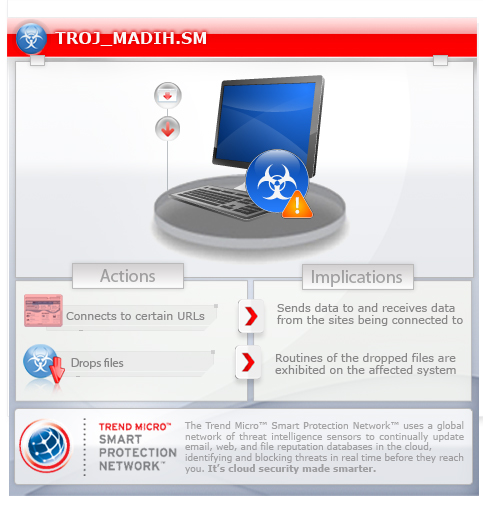TROJ_MADIH.SM
TrojanDownloader:Win32/Delf.QR (Microsoft); Trojan.Win32.Upof.c (Kaspersky); W32/Pinkslipbot (NAI)
Windows 2000, Windows XP, Windows Server 2003


Threat Type: Trojan
Destructiveness: No
Encrypted: Yes
In the wild: Yes
OVERVIEW
Dropped by other malware, Downloaded from the Internet
This Trojan is believed to be related to a targeted attack against infrastructures and companies located in the Middle East.
To get a one-glance comprehensive view of the behavior of this Trojan, refer to the Threat Diagram shown below.

This Trojan arrives on a system as a file dropped by other malware or as a file downloaded unknowingly by users when visiting malicious sites.
It connects to certain websites to send and receive information.
TECHNICAL DETAILS
279,040 bytes
EXE, DOC
No
19 Jul 2012
Connects to URLs/IPs, Drops files
Arrival Details
This Trojan arrives on a system as a file dropped by other malware or as a file downloaded unknowingly by users when visiting malicious sites.
Installation
This Trojan drops the following component file(s):
- %User Profile%\PrintHood\pangtip.bat
(Note: %User Profile% is the current user's profile folder, which is usually C:\Windows\Profiles\{user name} on Windows 98 and ME, C:\WINNT\Profiles\{user name} on Windows NT, and C:\Documents and Settings\{user name} on Windows 2000, XP, and Server 2003.)
It drops the following copies of itself into the affected system:
- %User Profile%\UpBackup\UpdateOffice.exe
- %User Profile%\PrintHood\UpdateOffice.exe
(Note: %User Profile% is the current user's profile folder, which is usually C:\Windows\Profiles\{user name} on Windows 98 and ME, C:\WINNT\Profiles\{user name} on Windows NT, and C:\Documents and Settings\{user name} on Windows 2000, XP, and Server 2003.)
Autostart Technique
This Trojan modifies the following registry entry(ies) to enable its automatic execution at every system startup:
HKEY_CURRENT_USER\Software\Microsoft\
Windows\CurrentVersion\Explorer\
Shell Folders
Startup = "%User Profile%\UpBackup"
(Note: The default value data of the said registry entry is %Start Menu%\Program\Startup.)
HKEY_CURRENT_USER\Software\Microsoft\
Windows\CurrentVersion\Explorer\
User Shell Folders
Startup = "%User Profile%\UpBackup"
(Note: The default value data of the said registry entry is %Start Menu%\Program\Startup (in hex values) .)
Other Details
This Trojan connects to the following website to send and receive information:
- http://{BLOCKED}.{BLOCKED}.57.28
- http://www.{BLOCKED}l.in/ASLK/khaki/Abi/UUUU.htm
It drops the following file(s)/component(s):
- %User Profile%\PrintHood\{ten letter random file names).TMP
- %User Profile%\PrintHood\{~20 letter random file names}.PRI
- %User Profile%\PrintHood\{abbreviated malware file name}.exe.pkxm
- %User Profile%\PrintHood\{ten letter random file names).dll
- %User Profile%\Templates\nam.dll
- %User Profile%\PrintHood\mahdi.txt
(Note: %User Profile% is the current user's profile folder, which is usually C:\Windows\Profiles\{user name} on Windows 98 and ME, C:\WINNT\Profiles\{user name} on Windows NT, and C:\Documents and Settings\{user name} on Windows 2000, XP, and Server 2003.)
SOLUTION
9.200
9.272.02
19 Jul 2012
9.273.00
20 Jul 2012
Step 1
For Windows XP and Windows Server 2003 users, before doing any scans, please make sure you disable System Restore to allow full scanning of your computer.
Step 2
Scan your computer with your Trend Micro product and note files detected as TROJ_MADIH.SM
Step 3
Identify and terminate files detected as TROJ_MADIH.SM
- If the detected file is displayed in either Windows Task Manager or Process Explorer but you cannot delete it, restart your computer in safe mode. To do this, refer to this link for the complete steps.
- If the detected file is not displayed in either Windows Task Manager or Process Explorer, continue doing the next steps.
Step 4
Restore this modified registry value
Important: Editing the Windows Registry incorrectly can lead to irreversible system malfunction. Please do this step only if you know how or you can ask assistance from your system administrator. Else, check this Microsoft article first before modifying your computer's registry.
- In HKEY_CURRENT_USER\Software\Microsoft\Windows\CurrentVersion\Explorer\Shell Folders
- From: Startup = "%User Profile%\UpBackup"
To: Startup = "%Start Menu%\Program\Startup"
- From: Startup = "%User Profile%\UpBackup"
- In HKEY_CURRENT_USER\Software\Microsoft\Windows\CurrentVersion\Explorer\User Shell Folders
- From: Startup = "%User Profile%\UpBackup"
To: Startup = "%Start Menu%\Program\Startup"
- From: Startup = "%User Profile%\UpBackup"
Step 5
Search and delete the file detected as TROJ_MADIH.SM
*Note: Some component files may be hidden. Please make sure you check the Search Hidden Files and Folders checkbox in the More advanced options option to include all hidden files and folders in the search result.
To manually delete a malware/grayware file from the affected system:
- Right-click Start then click Search....
- In the Named input box, type the name of the file that was detected earlier.
- In the Look In drop-down list, select My Computer then press Enter.
- Once located, select the file then press SHIFT+DELETE to delete it.
Step 6
Search and delete these files
- %User Profile%\PrintHood\mahdi.txt
- %User Profile%\PrintHood\pangtip.bat
- %User Profile%\PrintHood\{abbreviated malware file name}.exe.pkxm
- %User Profile%\PrintHood\{ten letter random file names).dll
- %User Profile%\PrintHood\{ten letter random file names).TMP
- %User Profile%\PrintHood\{~20 letter random file names}.PRI
- %User Profile%\Templates\nam.dll
Step 7
Scan your computer with your Trend Micro product to delete files detected as TROJ_MADIH.SM. If the detected files have already been cleaned, deleted, or quarantined by your Trend Micro product, no further step is required. You may opt to simply delete the quarantined files. Please check this Knowledge Base page for more information.
Did this description help? Tell us how we did.

